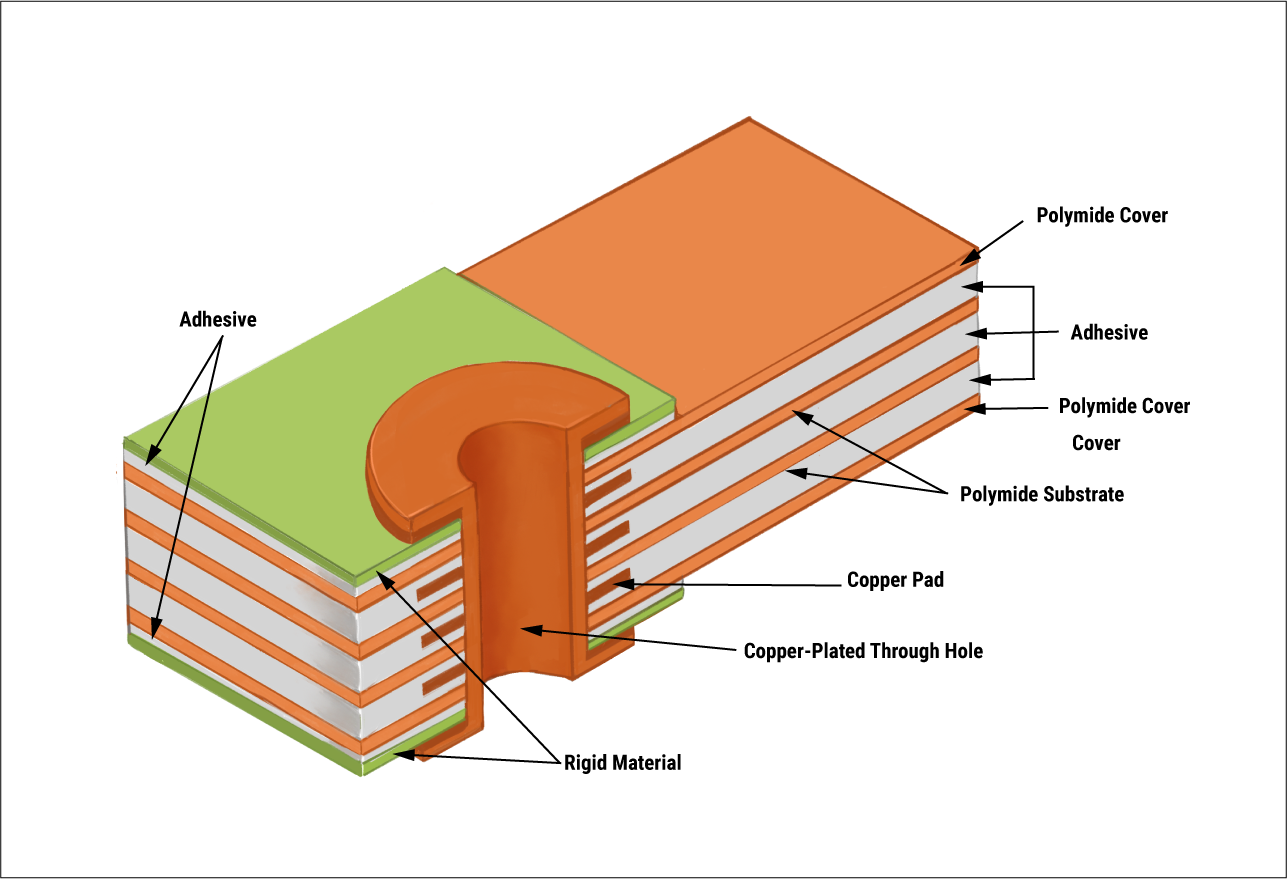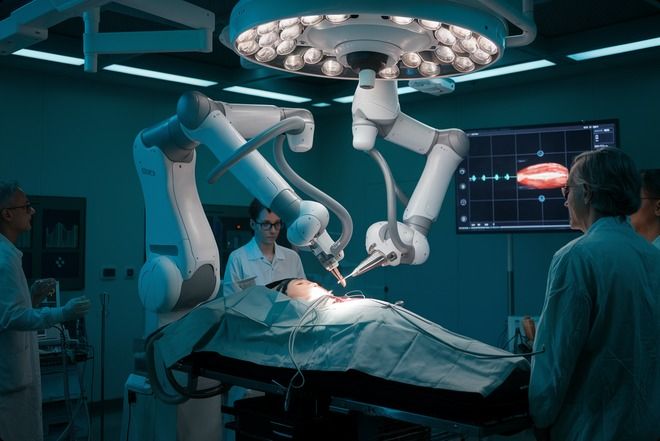In the rapidly evolving field of surgical robotics, rigid-flex PCBs (Printed Circuit Boards) play a crucial role in enhancing precision, flexibility, and reliability. For engineers and designers working on advanced surgical robots, understanding how rigid-flex PCBs contribute to robotic joint designs, dynamic flexing, and 3D configurations is essential. These innovative boards combine the stability of rigid circuits with the adaptability of flexible ones, making them ideal for the compact and intricate systems found in surgical applications.
In this blog, we’ll dive deep into the design and application of rigid-flex PCBs in surgical robotics. From their unique benefits to specific use cases and design tips, we’ll explore how these boards are shaping the future of medical technology. Whether you’re focused on flexible circuit design or 3D PCB design for surgical applications, this guide will provide actionable insights to help you optimize your projects.
What Are Rigid-Flex PCBs and Why Are They Important in Surgical Robotics?
Rigid-flex PCBs are hybrid circuit boards that integrate rigid and flexible layers into a single unit. The rigid sections provide structural support for mounting components, while the flexible sections allow the board to bend and adapt to complex shapes. This combination is particularly valuable in surgical robotics, where space is limited, and components must withstand dynamic movement without compromising performance.
In advanced surgical robots, rigid-flex PCBs are often used in robotic joints, end-effectors, and control systems. Their ability to handle dynamic flexing makes them perfect for applications requiring repeated motion, such as robotic arms performing precise incisions. Additionally, their compact design reduces the overall footprint, which is critical in minimally invasive surgical tools where every millimeter counts.

Key Benefits of Rigid-Flex PCBs in Surgical Robotics
Rigid-flex PCBs offer several advantages that make them indispensable in the design of surgical robots. Here are some of the most significant benefits:
- Space Efficiency: Surgical robots often operate in confined spaces, both within the device and inside the human body. Rigid-flex PCBs can be folded or shaped into 3D configurations, reducing the need for multiple boards and connectors. This saves space and minimizes weight, which is vital for handheld or wearable robotic systems.
- Reliability Under Stress: Robotic joint PCBs must endure constant movement without breaking or losing connectivity. Rigid-flex designs are tested to withstand millions of flex cycles, ensuring long-term reliability. For instance, a typical rigid-flex PCB might handle over 200,000 flex cycles before showing signs of wear, depending on the material and design.
- Reduced Signal Loss: In surgical robotics, high-speed data transmission is critical for real-time control and feedback. Rigid-flex PCBs minimize the use of connectors and cables, reducing impedance mismatches and signal loss. This ensures that signals travel at optimal speeds, often exceeding 5 Gbps in high-performance designs, to support precise robotic movements.
- Enhanced Durability: The integration of rigid and flexible materials creates a robust structure that resists vibration and mechanical stress. This durability is essential for surgical robots that operate in demanding environments, such as during long procedures or in emergency settings.

Applications of Rigid-Flex PCBs in Surgical Robotics
The versatility of rigid-flex PCBs makes them suitable for various components within surgical robots. Below, we explore specific applications that highlight their importance in flexible circuit design and dynamic flexing PCB configurations.
1. Robotic Joints and Articulation
Robotic joint PCBs are at the heart of surgical robots, enabling precise articulation for tasks like suturing or tissue manipulation. Rigid-flex PCBs are ideal for these joints because they can bend repeatedly without fracturing. Their flexible sections allow for smooth motion in multiple axes, while the rigid areas support sensors and actuators. For example, a robotic joint might require a bending radius as tight as 0.5 mm, which rigid-flex designs can achieve without compromising signal integrity.
2. End-Effectors and Surgical Tools
End-effectors, such as robotic scalpels or forceps, often incorporate rigid-flex PCBs to manage power and data in a compact form. These tools require intricate wiring to transmit control signals and sensor feedback. By using a single rigid-flex board, designers can eliminate bulky connectors, reducing the risk of failure during critical procedures. This is especially important in minimally invasive surgeries where tools must navigate tight spaces.
3. Wearable and Portable Surgical Devices
Wearable robotic systems, like exoskeletons for surgical assistance, benefit from the lightweight and adaptable nature of rigid-flex PCBs. These boards can conform to the device’s shape, ensuring comfort and functionality. Their ability to support 3D PCB design for surgical applications allows engineers to create ergonomic solutions that enhance surgeon precision while reducing fatigue during long operations.
4. Control Systems and Feedback Loops
Surgical robots rely on real-time feedback to adjust movements and ensure patient safety. Rigid-flex PCBs integrate sensors, microcontrollers, and communication modules into a single unit, streamlining data flow. With impedance control as low as 50 ohms in high-frequency designs, these boards maintain signal clarity, enabling rapid response times—often under 1 millisecond—for robotic adjustments.
Design Considerations for Rigid-Flex PCBs in Surgical Robotics
Designing rigid-flex PCBs for surgical robots requires careful planning to balance flexibility, durability, and performance. Here are key factors to consider when working on flexible circuit design and 3D PCB design for surgical applications:
- Material Selection: Choose materials that offer both flexibility and strength, such as polyimide for flexible layers and FR4 for rigid sections. Polyimide can withstand temperatures up to 260°C, making it suitable for sterilization processes common in medical environments.
- Bend Radius Optimization: Ensure the bend radius of the flexible sections is appropriate for the application. A radius too tight can cause stress fractures, while a radius too large may waste space. For robotic joint PCBs, a bend radius of 6-10 times the thickness of the flexible layer is often ideal.
- Layer Stackup: Plan the stackup to minimize signal interference, especially in high-speed applications. For instance, placing ground planes between signal layers can reduce crosstalk by up to 30%, ensuring reliable data transmission in dynamic flexing PCB designs.
- Component Placement: Position components on rigid sections to avoid stress during flexing. Sensitive components like sensors should be placed away from high-flex areas to prevent damage over time.
- Testing for Durability: Conduct flex cycle testing to simulate real-world use. Surgical robots may require boards to endure hundreds of thousands of cycles, so testing under conditions mimicking robotic joint movement is critical.

Challenges in Implementing Rigid-Flex PCBs in Surgical Robotics
While rigid-flex PCBs offer numerous benefits, their implementation comes with challenges that engineers must address to ensure success:
- Complex Manufacturing: Producing rigid-flex PCBs involves intricate processes, as the transition between rigid and flexible areas must be seamless. Misalignment during lamination can lead to delamination, reducing the board’s lifespan.
- Cost Considerations: Due to their specialized design and materials, rigid-flex PCBs can be more expensive than traditional rigid boards. However, their ability to reduce assembly costs by minimizing connectors often offsets this initial investment.
- Thermal Management: Surgical robots may generate heat during operation, and rigid-flex PCBs must dissipate this heat effectively. Engineers can incorporate thermal vias and heat sinks in rigid sections to manage temperatures, preventing performance degradation.
Future Trends: Rigid-Flex PCBs and the Evolution of Surgical Robotics
As surgical robotics continues to advance, rigid-flex PCBs will play an even larger role in shaping the industry. Emerging trends include the integration of AI-driven control systems, where rigid-flex boards will need to support higher data rates—potentially exceeding 10 Gbps—for real-time processing. Additionally, the push for smaller, more portable surgical devices will drive demand for innovative 3D PCB design for surgical applications, with rigid-flex configurations at the forefront.
Another exciting development is the use of biocompatible materials in rigid-flex PCBs, ensuring compatibility with implantable robotic systems. These materials will need to meet strict medical standards while maintaining the flexibility and durability required for dynamic flexing PCB designs.
How to Partner with a Trusted Manufacturer for Rigid-Flex PCB Solutions
For engineers working on rigid-flex PCB surgical robots, collaborating with a reliable manufacturing partner is key to success. Look for a provider with expertise in medical-grade PCB production, offering comprehensive design support and rigorous quality testing. Ensure they can handle tight tolerances and provide materials suited for dynamic flexing and high-frequency applications.
By partnering with a manufacturer that understands the unique demands of surgical robotics, you can streamline the development process and bring innovative solutions to market faster. From prototyping to full-scale production, the right partner will help you navigate the complexities of flexible circuit design and 3D PCB configurations.
Conclusion: Shaping the Future of Surgical Robotics with Rigid-Flex PCBs
Rigid-flex PCBs are transforming the landscape of advanced surgical robotics, offering unmatched flexibility, reliability, and compactness. Whether used in robotic joint PCBs, dynamic flexing designs, or 3D PCB configurations for surgical applications, these boards enable precision and innovation in medical technology. By understanding their benefits, applications, and design considerations, engineers can harness the full potential of rigid-flex PCBs to create cutting-edge surgical robots that improve patient outcomes.
As the field continues to evolve, staying ahead of trends and partnering with experienced manufacturers will be crucial. With rigid-flex PCBs at the core of your designs, you’re well-equipped to push the boundaries of what’s possible in surgical robotics, delivering solutions that are both efficient and life-changing.



